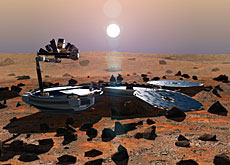The red planet comes closer

Mars and Earth have had their closest encounter in 60,000 years. On Wednesday, only 56 million kilometres separated the two planets.
Stargazers in Switzerland were hoping for a clear sighting of the red planet, which is now the brightest object in the night sky apart from the Moon.
Earth and Mars move at different speeds around the Sun. At present the Sun is on one side of Earth and Mars is on the other.
For astronomers this is a very impressive event. They calculate that the last time the two planets were this close was in 57,617 BC.
“It is really amazing how close and how red and how bright and big Mars is,” Andrea Hofmann of the Astronomical Youth Group in Bern told swissinfo.
Mars is visible even without a telescope.
“It is brighter than Jupiter right now which is the brightest planet usually. So it’s just the brightest object in the sky apart from the Moon,” said Thomas Schildknecht of the Institute of Astronomy.
On a clear night even small telescopes will reveal the planet’s polar cap and some of the surface structure.
Mountain view
The red planet can be viewed best just south of the Equator. Nevertheless, many amateur stargazers have travelled to the Swiss mountains to have a closer look at Mars.
But Professor Gerhard Beutler, director of the Institute of Astronomy, told swissinfo this would not make a difference:
“I would recommend that they take a chair with them to stand on so that they are even closer.
“But seriously, we are speaking here of distances of the order of 50 million kilometres. In this sense I cannot help the Swiss tourist industry.”
The red planet has always inspired science fiction writers. And the fact that Mars is currently closer to Earth has fuelled hopes of life on Mars. An increasing number of UFO sightings have been reported.
However, Beutler does not believe in green men on the red planet.
“I think such reports would be much more believable if space missions to Mars reported such sightings,” he told swissinfo.
Life on Mars?
But for Andrea Hofmann, Mars has merely an astronomical significance: “For me Mars represents the fourth planet of the solar system, our neighbour, the closest planet and probably the planet we will visit in the future.
“I think as its colour is red, it is a very strong and impressive planet,” she said.
Many people have visited the observatory in Bern this week to take a closer look at Mars. Hanna Einhaus was very excited about taking her first look at the planet.
“I am hoping to see something really big. When I was a little girl it was my dream to be an astronomer,” she said.
With Mars inspiring many fantasies, Schildknecht says this is an event not to be missed.
“This is really a brilliant event in the sense that Mars is so bright and people should go out and have a look at it, but they should not expect spectacular images, “ he said.
The next time Mars and Earth will be this close will be in 2287.
swissinfo, Daniela Silberstein
Wednesday saw Mars and Earth come within 56 million kilometres of each other.
The last time the two planets were this close was in 57,617 BC.
The best place to view the planet is south of the Equator.
The next time Mars and Earth will be this close will be in 2287.

In compliance with the JTI standards
More: SWI swissinfo.ch certified by the Journalism Trust Initiative











You can find an overview of ongoing debates with our journalists here . Please join us!
If you want to start a conversation about a topic raised in this article or want to report factual errors, email us at english@swissinfo.ch.